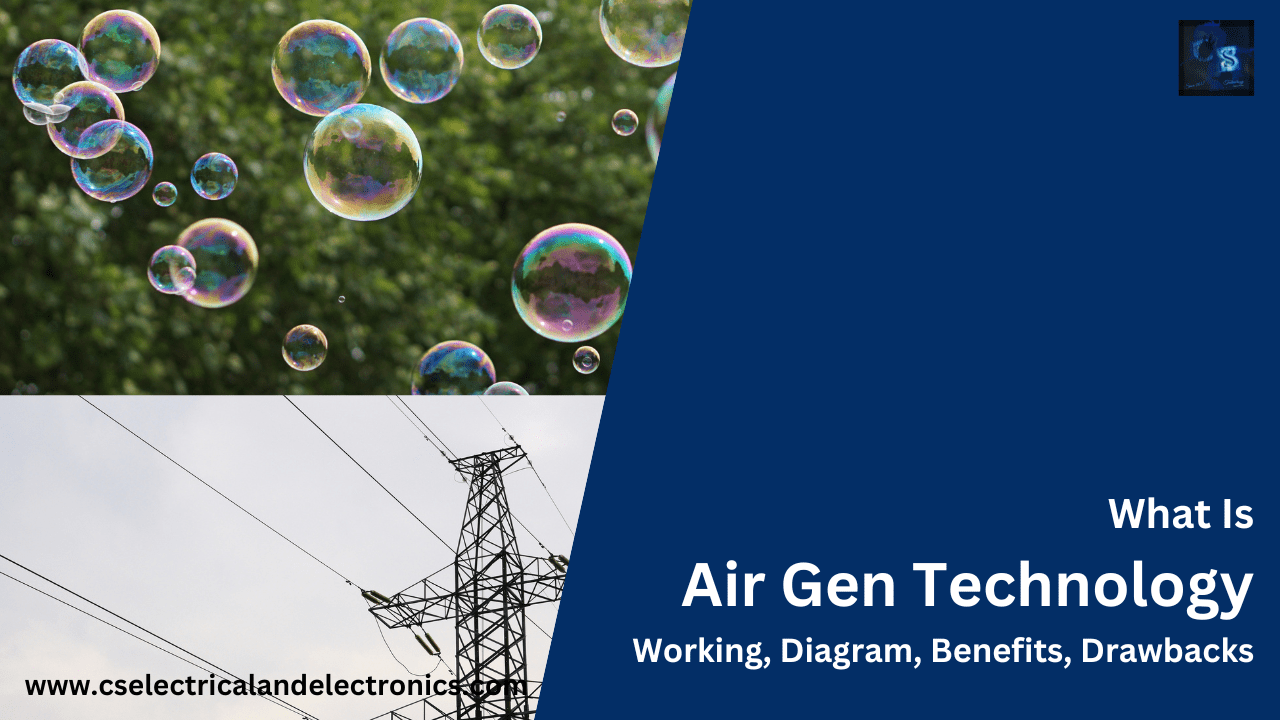What Is Air Gen Technology, Working Of Air Gen, Diagram, Benefits
Hello guys, welcome back to our blog. Here in this article, we will discuss what is Air Gen Technology, the working of Air Gen, the block diagram of Air Gen, and its advantages and disadvantages.
If you have any electrical, electronics, and computer science doubts, then ask questions. You can also catch me on Instagram – CS Electrical & Electronics.
Also, read the following:
- AI Tools For Electronic Circuit Design, Which Is Best?
- AI Artificial Intelligence Applications In Electric Vehicles | Future?
- Introducing The AI Parking Robots, Future Of AI Technology
Air Gen Technology
A revolutionary invention called Air Gen has the potential to completely alter how we produce electricity. It is a safe, reliable, and effective source of energy that could be utilized to power equipment in harsh or distant locations. But before it can be utilized widely, there are a few obstacles that must be solved because Air Gen is still in its early stages of development.
A gadget called Air Gen uses the water vapor that is already present in the air to produce electricity. It was created at the University of Massachusetts Amherst by Jun Yao and Derek Lovley. A film of protein nanowires taken from the bacteria Geobacter sulfurreducens makes up Air-gen. The way the nanowires are set up makes it possible for them to draw water molecules out of the atmosphere. A difference in electrical charge is produced when the water molecules interact with the nanowires. It is this charge imbalance that produces electricity.
How does Air Gen Technology work?
The protein nanowires’ ability to electrochemically decrease water serves as the foundation for the operation of Air Gen. Hydrogen and oxygen are created when water molecules interact with the nanowires. In order to produce electrons, the hydrogen ions are subsequently reduced at the nanowires’ surface. These electrons generate an electric current as they move through an external circuit.
Air is emitted with oxygen ions. “Biological water splitting” is the term for this action. Numerous bacteria engage in this mechanism naturally. To produce energy, Air Gen merely applies this method.
Block diagram of Air Gen
Below is a block diagram of the Air Gen.
Air Gen’s primary elements are:
- The sheet of protein nanowire
- The electrolyte mixture
- The electrodes
- External wiring
The most crucial element of Air Gen is the protein nanowire film. It is the location where water gets reduced electrochemically. The electrons are transferred from the nanowires to the electrodes using an electrolyte solution. The electrons are gathered by the electrodes, which then produce an electric current. Electric current is moved from the electrodes to a load using the external circuit.
In Air Gen, the protein nanowires are organized in a way that enables them to capture water vapor from the atmosphere. The positively charged hydrogen ions in the water molecules are drawn to the negatively charged surfaces of the nanowires. The nanowires reject the oxygen ions in the water molecules, causing them to escape into the atmosphere.
An extremely effective approach is the electrochemical reduction of water at the nanowires’ surface. An electric current is produced using the liberated electrons from the hydrogen ions. Currently, Air Gen has an efficiency of about 10%, but the researchers who developed the device are aiming to raise that number.
The electrons are transferred from the nanowires to the electrodes in Air Gen using an electrolyte solution. The pH balance of the system is also maintained by the electrolyte solution.
In Air Gen, electrons are gathered by the electrodes and used to produce an electric current. The electrodes are constructed of a readily oxidizing substance, like platinum or gold.
Electric current is moved from the electrodes to a load using the external circuit. Any device that uses electricity can serve as the load, including a lightbulb, a sensor, and a medical implant.
Benefits of Air Gen
Compared to other renewable energy sources, Air Gen has a number of advantages:
- It is a sustainable and clean source of energy.
- It is effective and has a considerable level of power output.
- It is adaptable and functional in a variety of humidity levels.
- It can be used to power devices in harsh or distant situations because it is portable.
Drawbacks of Air Gen
Additionally, Air Gen has a few drawbacks:
- The early stages of its evolution are still present.
- Currently, Air Gen’s efficiency is not very high.
- Air Gen still has a premium price tag.
Conclusion
A revolutionary new technology called Air Gen has the potential to completely alter how we produce electricity. It is a safe, reliable, and effective source of energy that could be utilized to power equipment in harsh or distant locations. But before it can be utilized widely, there are a few obstacles that must be solved because Air Gen is still in its early stages of development.
Additional details
- The name “Air Gen” is a combination of the words “air” and “generator”.
- 2015 saw the initial demonstration of Air Gen.
- Small electrical devices like sensors and implantable medical devices have been powered by air generation.
- The developers of Air Gen are aiming to increase the technology’s effectiveness and cost-effectiveness.
This was about “Air Gen Technology“. I hope this article may help you all a lot. Thank you for reading.
Also, read:
- 10 Tips To Maintain Battery For Long Life, Battery Maintainance
- 10 Tips To Save Electricity Bills, Save Money By Saving Electricity
- 100 (AI) Artificial Intelligence Applications In The Automotive Industry
- 100 + Electrical Engineering Projects For Students, Engineers
- 1000+ Automotive Interview Questions With Answers
- 1000+ Control System Quiz, Top MCQ On Control System
- 1000+ Electrical Machines Quiz, Top MCQs On Electrical Machines
- 1000+ MATLAB Simulink Projects For MTech, Engineering Students


